Izumo Taisha
- Izumo Taisha
- Kami-ari-zuki, The Month of the Gods
- The Shrine in the Clouds
- Izumo Taisha Festivals
Kami-ari-zuki, The Month of the Gods
While Japan now uses the same calendar as the West, up until the mid-1800’s it used a lunar calendar, and instead of the numbered names of the months they use now (Month 1, Month 2, Month 3, etc), each month had a more complicated name. The first month of the calendar was called Mutsuki, the second Kisaragi, the third Yayoi, and so on. When you get to the tenth month of that lunar calendar, it has a very interesting name: Kan-na-zuki, The Month of No Gods.
What does this have to do with Shimane? Well, in the Izumo region of Shimane, the same month is called Kami-ari-zuki, The Month of the Gods. Basically, for about a week during the tenth month of the lunar calendar, all of the myriad gods throughout the country (called by the collective name Yaoyorozu-no-kamigami) leave their respective areas and gather at Izumo Taisha in Izumo City, and special festivals and ceremonies are held at Izumo Taisha during this time.
It all starts with the Kami-mukae-sai, a ceremony that welcomes the gods to Izumo. It is held after sunset on the beach at Inasa-no-Hama (part of Sono-no-Nagahama from the Legend of Kunibiki), about a kilometer (3/4 of a mile) from the shrine. Bonfires are lit, and after a short ceremony, shrine priests escort the gods from the beach back to special shrines on the Izumo Taisha grounds, where the myriad gods are then temporarily enshrined. This procession is blocked from direct view on either side by white fabric also carried by Taisha priests. While the gods are at Izumo Taisha, they are said to hold meetings to determine the destiny of all people for the upcoming year, and people come from all over the country to pray for good luck in the various relationships they will have. The gods also are said to have feasts where they enjoy the sake offered up by local brewers. Finally, they are seen off in another special ceremony called the Karasade-sai, after which the gods all return to where they came from.
As Kami-ari-zuki is based on the lunar calendar, the dates on which it is held change from year to year, but it usually happens every November. Along with the usual ceremonies connected to this, other special events are often held at Izumo Taisha, so this is an ideal time to come and visit the shrine.
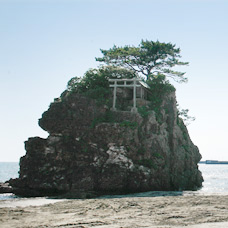
During Kami-ari-zuki, the gods first arrive at Inasa-no-hama beach before going to Izumo Taisha.
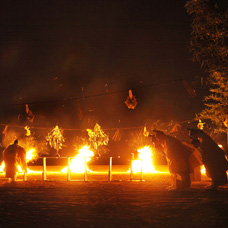
The Kami-mukae-sai ceremony welcomes the gods to the land of Izumo during Kami-ari-zuki.
Visiting Locations connected to Izumo Taisha
Izumo Taisha is located on the western end of the Shimane Peninsula, in the Taisha area of Izumo City. A large shrine gate, said to be the largest in Japan, towers over the main road to Izumo Taisha and welcomes visitors to the area. Izumo Taisha is easily accessible by car, bus, or train, and the area around the shrine bustles with tourists and visitors to the shrine, especially on the weekends.
If you follow the road that passes in front of the shrine grounds, you will soon arrive at Inasa-no-Hama beach. This beach is part of Sono-no-nagahama, a place that plays a large role in the Kunibiki legend, and is where Takemikazuchi presented Okuninushi with his demands to turn over Ashihara-no-nakatsukuni to Amaterasu, and where Takeminakata challenged him to a test of strength. It is also where, every year at the Kami-mukae-sai, all of the gods from around Japan are welcomed to Izumo Taisha, and the procession back to Izumo Taisha from the beach follows a path through town along the Kami Mukae Road.
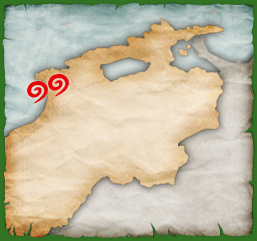
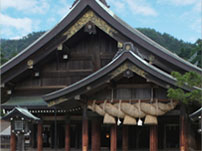
Izumo Taisha
195 Kizukihigashi, Taisha-cho, Izumo City, Shimane
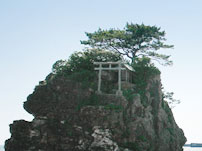
Inasa-no-Hama
Kizukikita, Taisha-cho, Izumo City, Shimane













